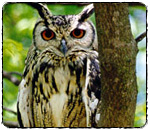|
Apparently the rarest avian creature in the Auroville bioregion is the Bubo bubo bengalensis, the Indian sub-species of the Eurasian eagle owl. Confined to peninsular India, Sind in Pakistan and Marakan in Burma (where it may now be extinct), it faces a high risk of total extinction in the near future (conservative estimates put the country-wide population of breeding birds at less than 2,000 pairs). |
|
Reasons for its endangered condition |
|
An inhabitant of the deeply scored ravines and gullies, it clings to a precarious existence as human pressure drives it out of its preferred habitat (land
 development activities treat ravines and gullies as sewage dumps, the rock faces are intensely mined for pebbles and 'blue metal chips', and erosion leads to build-up of silt, which slowly but steadily fills up the canyons). The indiscriminate use of pesticides in the environment, which steadily build up in the tissues of this bird, rendering it infertile (adding to its mortality), is another apparently insurmountable problem. Add to this local mythical beliefs (which consider owls as creatures of ill omen and harbingers of death) and the general apathy towards the plight of this species by environmentalists themselves, and their future looks very bleak indeed. development activities treat ravines and gullies as sewage dumps, the rock faces are intensely mined for pebbles and 'blue metal chips', and erosion leads to build-up of silt, which slowly but steadily fills up the canyons). The indiscriminate use of pesticides in the environment, which steadily build up in the tissues of this bird, rendering it infertile (adding to its mortality), is another apparently insurmountable problem. Add to this local mythical beliefs (which consider owls as creatures of ill omen and harbingers of death) and the general apathy towards the plight of this species by environmentalists themselves, and their future looks very bleak indeed.
|
|
Peculiar and distinctive 'who-whooo' call |
|
This impressive bird, with its arresting orange-yellow eyes, can be seen in the Ravena, Forecomers, Success, Utility and Bommaiyapalayam canyons. It spends the day sitting motionless in a cleft in a rock face or under a bush, relying on its cryptically coloured plumage for camouflage. At dusk it sets out from its hiding place, preceded and accompanied by its peculiar and distinctive 'who-whooo' call, which though not loud, has a curious far-carrying quality. |
|
Predatory nature |
|
The various species of rodents found in these parts (gerbils, mice, mole rats and rats) constitute the prey base of 'Bubo bubo' (a single owl has been known to consume nearly 300 rodents in a year), and the predatory nature of the species keeps their numbers in check. At times other birds, snakes, lizards, frogs and even other owls are consumed. |
|
Breeding habits |
|
The breeding period in these parts of its range is from December to April. Sometimes three, but more commonly two, eggs are laid on the ground in a sheltered spot among the rocky cliffs (no nest is made) at staggered intervals. After an incubation period of approximately 45 days, the eggs hatch, again at irregular intervals, so much so that when the last chick emerges the eldest is 15 days old and capable of feeding by itself. Usually only one chick survives (cannibalism and Cainism is all too frequent - the larger chick killing and eating its younger nest mates). The survivor matures rapidly, and is capable of flying in less than 45 days. |
|
Unfortunately, most details concerning the natural history of this bird remain unknown and shrouded in myth. Hopefully, at some stage, someone will make an effort to unravel the fascinating secrets of its private life before it's too late; in fact, the sooner the better..! |
| TOP |
|